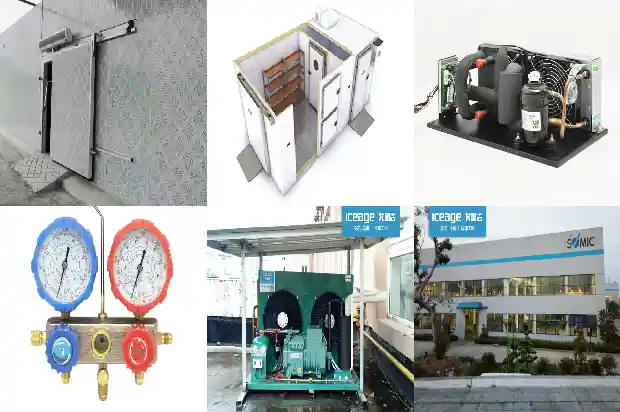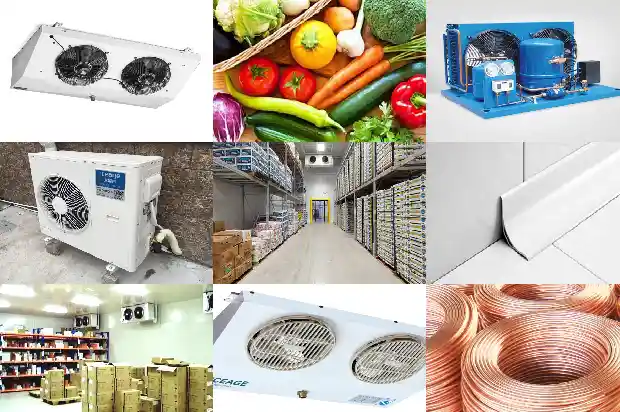Scheme for the Use and Safety of Ammonia Refrigerants
2024-09-30
I. About Ammonia Refrigerant
Ammonia is a good refrigerant. It belongs to natural working medium with ODP = 0 and GWP = 0. Currently, it has the best thermodynamic performance, the highest refrigeration efficiency, low price and low operation and maintenance cost. It has a history of more than a hundred years. At present, more than 85% of large-scale refrigeration systems for industrial and commercial refrigeration in China use ammonia.
The vapor is colorless and has a strong irritating odor. A very small amount of ammonia leakage (3-5 ppm) will be detected. The explosive limit concentration in the air is 15-28%.
Ammonia is a good refrigerant. It belongs to natural working medium with ODP = 0 and GWP = 0. Currently, it has the best thermodynamic performance, the highest refrigeration efficiency, low price and low operation and maintenance cost. It has a history of more than a hundred years. At present, more than 85% of large-scale refrigeration systems for industrial and commercial refrigeration in China use ammonia.
The vapor is colorless and has a strong irritating odor. A very small amount of ammonia leakage (3-5 ppm) will be detected. The explosive limit concentration in the air is 15-28%.
II. Hazard Sources of Ammonia
Operating room: Manual labor, dense personnel, closed environment. After a hazard occurs, it is difficult to evacuate urgently.
Cold storage: Food is piled up and the environment is closed. It is not easy to detect after a leak.
Machine room: A large amount of ammonia liquid is stored. It is a key location for another explosion.
Surrounding environment: It should be far away from areas with high population density.
Operating room: Manual labor, dense personnel, closed environment. After a hazard occurs, it is difficult to evacuate urgently.
Cold storage: Food is piled up and the environment is closed. It is not easy to detect after a leak.
Machine room: A large amount of ammonia liquid is stored. It is a key location for another explosion.

Surrounding environment: It should be far away from areas with high population density.
III. Evaluate Ammonia Realistically
Some enterprises, when promoting ammonia as a natural working medium, overly beautify ammonia refrigerant, mentioning more advantages and fewer disadvantages. The characteristics of ammonia being flammable, toxic and corrosive determine that safety technical measures for ammonia systems must be strengthened. Compared with industries such as chemical, coal mining, petroleum, and petrochemicals, the danger of ammonia is relatively small. In daily life: electricity, water, gas, buildings... dangers exist all the time. All accidents result from negligence, carelessness, and management loopholes. Man-made disasters are greater than natural disasters!
Some enterprises, when promoting ammonia as a natural working medium, overly beautify ammonia refrigerant, mentioning more advantages and fewer disadvantages. The characteristics of ammonia being flammable, toxic and corrosive determine that safety technical measures for ammonia systems must be strengthened. Compared with industries such as chemical, coal mining, petroleum, and petrochemicals, the danger of ammonia is relatively small. In daily life: electricity, water, gas, buildings... dangers exist all the time. All accidents result from negligence, carelessness, and management loopholes. Man-made disasters are greater than natural disasters!
IV. Causes of Disaster Accidents
- Fire causes secondary disasters. Fire, high temperature, causes pressure to rise and explosion.
- Improper manual defrosting operation results in liquid hammer or closed-circuit defrosting, causing pipeline rupture.
- Defrosting accidents of individual quick-freezing machines cause a large number of casualties. Equipment and pipelines are aging or management is not strict.
- System pipelines, valves and other facilities are aging, leaking, and design and installation are not standardized.
- The use of materials that do not meet fire protection standards and open fire operations such as electric welding with ammonia.
V. Unavoidable Problems
- The charging amount of the refrigeration system with direct evaporation of ammonia is large.
- Ammonia directly enters densely populated operating rooms and food freezing and cold storage rooms.
- In the event of irresistible factors such as fire and earthquake, secondary disasters of ammonia will inevitably occur.
VI. Schemes for Ammonia Safety
- Minimize the charging amount of ammonia to the greatest extent.
The critical amount of ammonia is specified as 10 tons.
- Limit ammonia to a specific area in the machine room and keep it away from areas that can cause personal and food safety such as operating rooms and cold storages.
- Take active defense measures for the ammonia system and prevent with concentration monitoring and alarm. Active defense: alarm, high-altitude discharge, spraying, and emergency shutdown of equipment interlock control.
VII. Schemes for Ammonia Safety
When ammonia leakage occurs in an area, the active safety defense system will, according to the amount of ammonia leakage:
When ammonia leakage occurs in an area, the active safety defense system will, according to the amount of ammonia leakage:
- Sound and light alarms prompt operators that there is an ammonia leakage accident.
- The accident exhaust fan starts to discharge the leaked ammonia to the outside.
- The water curtain spraying uses water to separate the dangerous area at the ammonia leakage point.
Technical points of water curtain spraying: Prevent the formation of the explosive limit of ammonia, prevent water from entering electrical switches, etc. Shutdown control must be carried out according to the refrigeration system process to avoid simultaneous shutdown, ensure the quality of equipment after an accident, and ensure the reliability and timeliness of the spraying water treatment system and spraying system.
VIII. Defrosting Method: Automatic Instead of Manual
Inlet pipeline: stop valve → filter → solenoid valve → check valve → stop valve.
Return air pipeline: stop valve → two-stage opening solenoid valve → stop valve.
Hot ammonia pipeline: stop valve → filter → solenoid valve → check valve → stop valve.
Drain pipeline: bypass valve.
Inlet pipeline: stop valve → filter → solenoid valve → check valve → stop valve.
Return air pipeline: stop valve → two-stage opening solenoid valve → stop valve.
Hot ammonia pipeline: stop valve → filter → solenoid valve → check valve → stop valve.
Drain pipeline: bypass valve.
IX. Liquid Explosion and Liquid Hammer
Liquid explosion: The incompressibility of liquid and thermal expansion.
Prevention: Correct operation to avoid full liquid and liquid hammer.
Causes of liquid explosion formation:
Liquid explosion: The incompressibility of liquid and thermal expansion.
Prevention: Correct operation to avoid full liquid and liquid hammer.
Causes of liquid explosion formation:
- During the defrosting process, the liquid in the heat exchange tube group is full or there is too much liquid.
- The valves at both ends of the low-temperature liquid pipeline are closed, and the pressure rises after heating (such as the valve from the ammonia pump to the regulating station).
Liquid hammer: High-speed liquid impact.
Prevention: Correct operation, slow down pressure increase and decrease.
The formation of liquid hammer is mainly in the following two situations: - Before defrosting, close the liquid supply valve. The recovery of ammonia liquid in the heat exchange tube group is not thorough. There is liquid in the return air pipeline. At the beginning of defrosting, the hot ammonia inlet valve is opened too quickly. High-pressure gas pushes the liquid in the return air pipeline to flow at an accelerated speed (due to the influence of pressure difference. A pressure difference of more than 8 bar). A high-speed liquid flow is generated in the return air pipeline. When an obstacle is encountered, liquid hammer will occur. The hot ammonia inlet valve must be opened slowly.
- When defrosting is completed, the liquid in the heat exchange tube group is not depressurized, and the return air valve is opened too quickly.
X. Increase Emergency Treatment Facilities in the Warehouse
- Ammonia concentration detection and alarm device and water supply system.
- Add shielding barriers to the liquid storage tank.
- Alarm for ultra-high liquid level in the liquid storage tank.
- A special high-altitude emergency ammonia discharge is set up to be discharged into a water container.
- During the ammonia safety defense transformation and hot ammonia defrosting, the pressure before entering the evaporator must not exceed 0.8 MPa.
- It is prohibited to speed up the defrosting speed by reducing or closing the inlet valve of the condenser.
- Active defense measures for ammonia systems can be adopted in both machine rooms and warehouses.
- Only by minimizing the charging amount can the harm be reduced.
Related Articles
- What Are the Common Causes of Cold Air Blower Noise?
- Four Combustible and Explosive Refrigerants: Precautions When in Use!
- Welding Equipment Used in Refrigeration System Maintenance
- Air - conditioner Low - pressure Alarm? These Nine Common Causes
- Could a Tiny Copper Tube Cause a Multi - split Air Conditioner to Stop Cooling? Refrigeration Workers Must Pay Attention!
- What Are the Causes of Scroll Compressor Damage?
- Do You Know These Four Scenarios That Can Cause Compressor Failures?
- Common Faults and Corresponding Solutions of Chillers During Use
- Causes and Prevention of "Primary Condensation" and "Secondary Condensation" in Fan - Coil Units
- How to Select and Use Water Pumps for Air - conditioning Systems?
- Why Can't Ordinary Motors Be Used as Variable - Frequency Motors?
- 10 Symptoms and Causes of Abnormal Frosting in Heat Pumps
- Common Causes and Analysis of High and Low Pressure Alarms
- Common Causes and Analysis of Compressor Thermal Protection
- Precautions for the Installation and Use of Water Flow Switches
- What Sensors Are Used for Leak Detection of R1234yf, the New Generation of Environmentally Friendly Refrigerant?
- Maintenance and Operation of Freezing and Cold Storage Warehouses
- 4 Points on Causes of Water Leakage in Closed Cooling Towers
